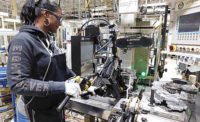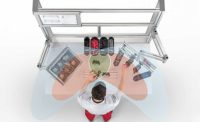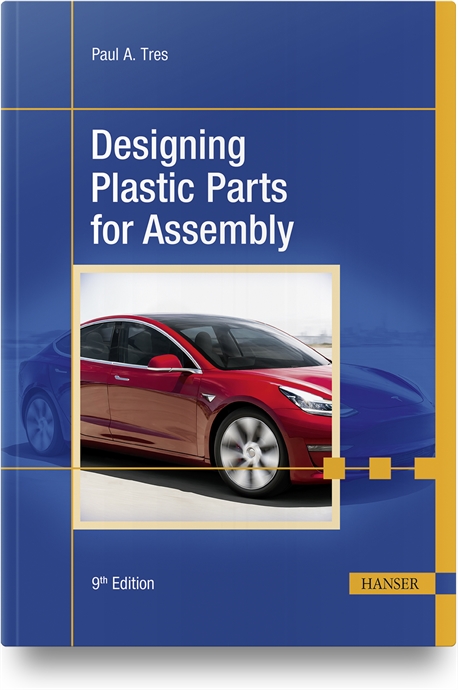The first wheeled suitcases appeared 50 years ago. Before 1970, luggage was lugged and shoved through airport terminals around the world. By adding casters, the humble invention transformed travel and eventually led to the carry-on bag trend.
Mobility is also becoming more important for workstations today, whether it’s to meet demand for flexible production, to make parts-picking operations more efficient or simply to reconfigure a line to meet social distancing requirements.
Mobile workstations appeal to manufacturers in all industries, especially companies that specialize in high-mix production or require quick line changeovers. Contract manufacturers, in particular, like the ability to easily reconfigure assembly lines as products change or volumes dictate.
“We design and build quite a few mobile workstations,” says Keith Soderlund, vice president of Creform Corp. “They’re a big advantage for contract manufacturers that need to do small production runs or experience a lot of product variety.
“Many manufacturers want as much flexibility as possible,” explains Soderlund. “Flexibility for rapid response is highly valued by manufacturers today and can give them a competitive advantage.”
Mobility enables engineers to quickly reconfigure workcells or assembly lines to address model changes or to implement continuous improvement ideas. Easy mobility also enhances quick production set ups and supports high-mix production environments.
“With mobile workstations, you can set up a workcell for a small batch run or easily adapt to major line changes,” Soderlund points out. “You can also quickly move things around for different staffing requirements. For instance, it’s especially helpful when you bring in temp workers for a surge production project.
“Some manufacturers that have mobile workstations hardly ever move them, while others change their assembly line configurations all the time,” notes Soderlund.
Wheels of Function
Workstations equipped with swiveling casters enable end users to easily push them and maneuver in tight spaces. But, it’s not just a matter of adding wheels. Brakes and locking mechanisms are equally important.
While a wheel brake will prevent roll, swiveling can still be an issue with mobile workstations. A slight bump can cause a table to slightly move back and forth.
“A total brake caster will lock both the wheel and the swivel,” says Soderlund. “If you have just a regular caster, it can be frustrating when the work surface wiggles around. That extra little bit of movement can be irritating.”
Most workstation suppliers offer several different choices in casters. For instance, there are rubber and urethane wheels available, in addition to anti-static wheels. However, urethane is typically a little easier to roll.
While the idea of adding casters to workstations is not new, it’s a concept that has become increasingly popular with manufacturers.
“Lately, there has been growing interest in mobile workstations,” says Bob Simmons, vice president of Proline. “They are ideal if your workflow switches from application to application throughout the day.
“People are reconfiguring lines more often today to be more nimble,” explains Simmons. “It’s part of lean manufacturing initiatives that emphasize work flow and waste reduction.
“Cleanliness is also an issue,” Simmons points out. “Mobile workstations are much easier to clean than fixed workstations. You can just pull out a unit, clean the area underneath or behind it and then push it back into place.”
“More manufacturers are getting away from fixed workstations today,” adds Dan Smith, national sales manager at Treston Inc. “They want to be able to reconfigure their assembly lines.
“We started to see this trend a few years ago,” notes Smith. “Although demand is increasing, mobile workstations still represent less than half of our total sales.
“We have also seen a lot of our existing customers just ordering casters,” says Smith. “They want to retrofit their existing stationary workstations.”
Treston’s newest product is available with or without wheels. The TED (Treston Electric Desk) is a motorized height-adjustable bench for light-duty applications. It has a load capacity of 330 pounds, plus a height range from 25 to 50 inches.
“Mobile workstations can be used across nearly all industries in many different types of production settings,” says Chad Johnson, product manager at Bosch Rexroth Corp. “Workstations are shifting from being designated subassembly stations to now being integrated into the main line as a workcell.
“In addition, we are seeing more and more workstations [positioned] alongside collaborative robots,” Johnson points out. “This allows for streamlined production in any manufacturing setting.
“Many manufacturers today see a need for mobile workstations because of [rapidly changing business conditions],” explains Johnson. “This requires flexibility on the manufacturing floor, which has created a need for [mobility] that did not exist in the past.”
Quick Reconfiguration
Mobile workstations allow for regular adjustments in assembly lines and quick reconfigurations of assembly processes, including modular integration with flow racks, kitting carts, material handling equipment and pick-to-light systems.
Mobile workstation can also benefit assemblers by eliminating waste and decreasing the amount they have to walk. Fewer steps means less fatigue and an improved worker experience that improves employee health and productivity.
“I’m seeing a greater focus on ergonomics and operator comfort lately, and that’s creating more demand for mobile, height-adjustable workstations,” says David Verrill, sales and applications manager at IAC Industries Inc. “There is also a greater variety of wheels being requested, as the old standard of black, hard rubber casters seems to be fading lately.
“Nonmarking casters, such as gray Performa rubber, are becoming more prominent, as are leveling casters,” explains Verrill. “The latter is a combination design that employs a caster wheel that can be retracted, leaving a leveling floor glide in its place. The design is excellent for applications that require only occasional mobility, but absolute stability when the workstation is in its ‘parked’ position.
“Wheels can add about $150 to the average cost of a workstation,” Verrill points out. “But, you pay a small amount of money to get versatility and prepare for whatever you can’t predict will happen in your plant in the future.
“In my opinion, long-term adaptability is always important, since workstations are very durable and will serve their purpose for decades,” says Verrill, who has worked in the industry for several decades. “A workstation on casters enhances the ability to reconfigure without time-consuming line shutdowns, regardless of the assembly task.
“Even manufacturers that have little or no need to rearrange their workstations appreciate casters, because they ease their housekeeping programs,” claims Verrill.
According to Verrill, one of the newest trends in mobile workstations is growing demand for compact, vertical units that can be easily wheeled around a factory floor. One example is IAC’s Smart Mobile Workstation (SMS).
“The SMS has been really popular in some assembly applications, and in ways that we hadn’t originally envisioned when it was being designed,” says Verrill. “Since we have the ability to design and build custom products, engineers see this product as a blank canvas upon which they can create their own visions for their assembly and test areas.
“The SMS is a flexible alternative to ‘bench-centric’ workspaces,” explains Verrill. “For a compact mobile solution, it has become a popular alternative to the traditional mobile workstation.”
A similar product is the MAX Mobile Workstation from ACD USA Inc. It’s designed to serve as a mobile desk on assembly lines.
The workstation features a basic metal frame that is 45 inches tall, 20 inches wide and 23 inches deep. It is available in a variety of customizable configurations. Customers can specify add-on options, such as drawers, shelves, tool booms, wipe-off boards and Peg Boards to hold hand tools. Even cupholders are available.
Rechargeable lithium-ion batteries are built into the bottom of the unit so that engineers can use laptop computers, printers and other electronic devices as they move around different parts of a factory.
“Quality control and inventory tracking are two popular applications for the MAX workstation,” says Chris Gould, director of sales at ACD USA. “It enables a manager or technician to move from cell to cell. They can easily take tools with them, such as gauges, scales, and test or measurement instruments.
“Data capture and follow-up during production processes is becoming more important,” notes Gould. “With fewer workers per square foot in most assembly plants today, due to automation, there is an increased need for people to travel from cell to cell or line to line. Typically, they need to have access to computer equipment and the ability to enter data along the way.
“The MAX workstation provides this mobile office function, enabling managers to print bar codes, labels, RFID tags, or A3 and PDCA reports at different points,” adds Gould. “Because production conditions can change fast, mobile workstations enable people to adapt to new environments on an as-needed basis.”











